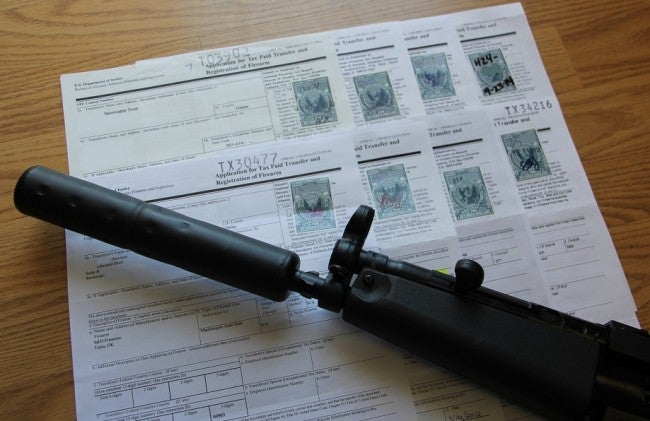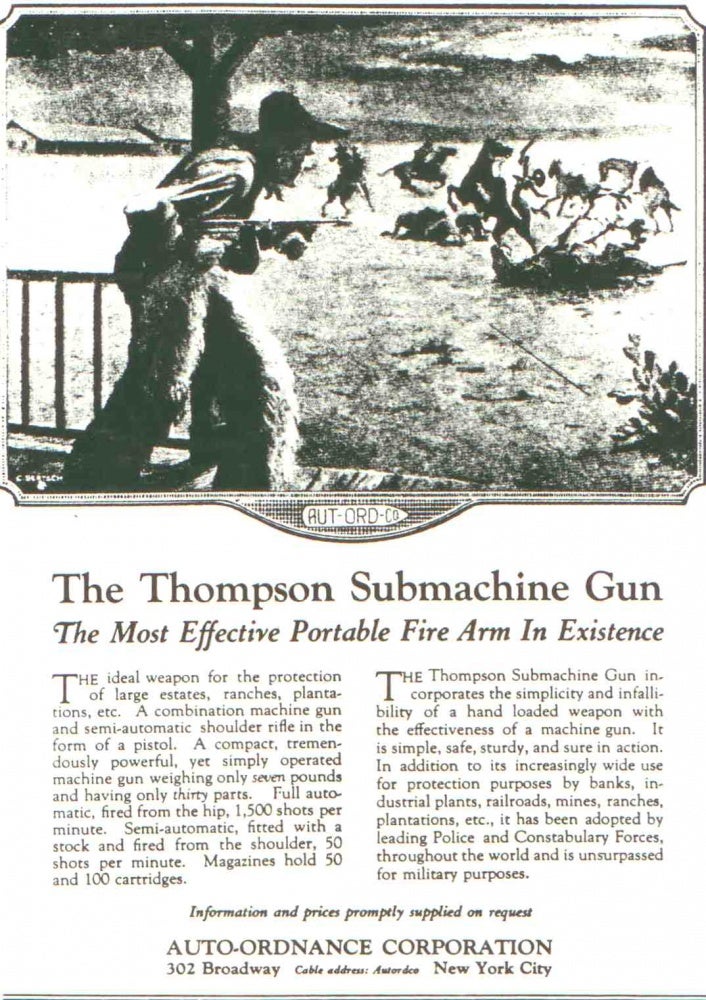I love machine guns. They don’t call the selectors on automatic firearms “fun switches” for nothing, and I have yet to hand off a machine gun to someone and have it not bring a smile to their face (it brings me joy exposing people to full auto for the first time). For the sake of this article, the word “machine gun” will meet the ATF’s definition: Any weapon which shoots, is designed to shoot, or can be readily restored to shoot, automatically more than one shot without manual reloading, by a single function of the trigger.
The machine gun was invented by American Hiram Maxim, and interestingly enough, the USA is one of the few countries on the planet where regular folks can in fact own a fully automatic firearm. In fact, machine guns have never been illegal in the USA on a federal level. They are heavily regulated, but not illegal at all.
The timeline of machine gun legislation is as follows:
Prior to 1934, machine guns were not regulated any differently than any other firearm. You could quite literally order a machine gun from a mail order catalog… and people did. Thompsons for example initially did not interest the military too terribly much, but the guns found a niche with individuals seeking personal protection, police agencies, and unfortunately, gangsters. Ads like this were not uncommon:
Prompted by prohibition era gangsters and the rise of organized crime (law enforcement was seriously outgunned by the likes of bad guy like Dillinger), the United States drafted the National Firearms Act which passed in 1934. The National Firearms Act did not ban machine guns, but it made them impossible to afford for most people. To buy a machine gun under the 1934 NFA, an individual needs to submit the following (the procedure remains unchanged even today):
- Pay a tax of $200, which in 1934 was worth over $3,500
- Fill out a lengthy application to register your gun with the federal government
- Submit photographs
- Submit passport photos
- Get your chief law enforcement official to sign your application
- Wait for the results of your background check to come back
A violation of the national firearms act results in a felony punishable by up to 10 years in federal prison, a $100,000 fine, and forfeiture of the individual’s right to own or possess firearms in the future.
The next big piece of legislation pertinent to machine guns occurred in 1968 with the Gun Control Act. The Gun Control Act established that imported firearms that had “no sporting purpose” were not able to be sold to civilians. Machine guns as a whole were determined to have no sporting purpose, and thus any MG imported after ’68 are able to be owned only by dealers, military, and police agencies. One bit of good this act did was allowed for a registration amnesty. It became apparent that there were so many unregistered machine guns in the US that had been brought back by veterans, that they should be able to register them tax free. Luckily many of them did, but the amnesty ended after just one month (the feds owe us another few months, this humble author believes).
The last piece of machine gun legislation is to many the coup de grace. In 1986 the Firearm Owners Protection Act was intended to prevent the federal government from creating a registry of gun owners. At the last minute, William Hughes added an amendment that called for the banning of machine guns. Charlie Rangel said that the “amendment in the nature of a substitute, as amended, was agreed to.” However, after the voice vote on the Hughes Amendment, Rangel ignored a plea to take a recorded vote and moved on to Recorded Vote 74 where the Hughes Amendment failed. The bill passed on a motion to recommit. Despite the controversial amendment, the Senate adopted H.R. 4332 as an amendment to the final bill. The bill was subsequently passed and signed on May 19, 1986 by President Ronald Reagan. Thus, Reagan’s signature banned the registration of new machine guns in the USA.
So what does this mean? This is where it gets complicated:
- Machine guns are not illegal, but it is illegal to make and register new ones on a form 1 (as you would do for an SBR)
- There is no way around the May 19th, 1986 date. if the machine gun in question was made after that date, you may not own it (unless you are a dealer)
Also, there are three types of machine guns that determine the gun’s legal status:
- Transferable: Guns registered prior to May 19th, 1986 that are able to be owned by everyone. There are only 182,619 transferable machine guns according to the ATF.
- Pre-Samples: Machine guns imported after 1968 but before May 19th, 1986. The 1968 GCA established that machine guns with no sporting purposes could not be sold to civilians. Dealers can however buy them and keep them after they give up their licenses. As a general rule, pre-samples cost about half that of a transferable.
- Post-Samples: Machine guns made after the May 19th, 1986 cutoff date. These are only for dealers, manufacturers, military, and police. A manufacturer who pays $500 a year is permitted by the federal government to manufacture these. A dealer (who is not a manufacturer) may acquire these if a police agency provides a “demo letter”. A demo letter is simply a letter from a PD asking you to acquire a sample gun for them to test and evaluate for potential purchase. Unfortunately dealers must sell or destroy post samples when they give up their license.
So that is that. I have looked and looked to try and find out NFA facts and a window into the registry, but most of it is internet lore and information from manufacturers records. I have seen the following as per estimates of how many of what exist:
a. 7,200 Hk sears
b. 6,000 FNC sears
c. 20,000 M11/9s
d. 500 SWD Lightning Links
e. 500 RIA M60s
f. 3300ish Group Industry (aka Vector) Uzi’s
g. At least 20,000 M16s
h. The NFA records are completely messed up , the ATF says the error rate on pre-68 records is 50%.
i. You have to assume that probably 10 to 20% of the 183K registered guns are easily gone now since 1943 (lost, stolen, damaged beyond repair). You have to remember that prior to 86 there wasnt a whole lot of value in a damaged M16 when the transfer or making tax was 1/3 the cost of the gun itself. Similar to suppressors today, who buys a used or damaged can when 25% of the value is in the transfer tax and you could just buy a new one from a dealer.
As a result of the closed registry, we cannot get new machine guns. We simply trade the ones that have been out there for years. This has resulted in very high prices. For example, one can get an AR15 for $600-700 in the USA, but I have seen converted automatic AR15s sell for $17,000. Factory Colt guns can go for $25,000+. Uzis which were a few hundred dollars back in the day are now bringing $12,000! This has created a small fiat driven marketplace for an extremely low amount of goods with an insanely high demand. For example, this here is a rather unremarkable piece of steel:
The bit of hardened steel is a registered Fleming HK sear. I have seen one sell for $27,000 so at roughly 0.25 ounces, that makes this steel worth $108,000 an ounce which makes it perhaps the most expensive metal on the planet (barring some obscure lanthanide or actinide) and 83 times more expensive than gold!
However, as the value on machine guns very seldom goes down, you could probably get your wife to understand your desire to buy one with the old “it’s an investment honey”. It sure is an investment too. I bought my first MG in January of 2010 for $3,000, and it is now worth $5,500. That is a 54% return on my purchase in just four years! I wish that all of my investments were like that one, and this even encouraged my father to get into the game (he even bought himself a machine gun not too long ago as an investment he can enjoy). That said, I would gladly take the monetary hit on my collection if others and myself could acquire post samples freely like they can suppressors.
A few frequently asked questions:
- How does this guy on youtube have all these cool post-86 machineguns? He is either a dealer, a friend of a dealer, or a manufacturer. We were able to perform our series on the KRISS Vector because representatives from KRISS were there.
- What are you and everyone else going to do when they repeal the machine gun ban? I don’t see this happening, but I would rejoice. I would love for sub-gun matches to become more common, rather than meetings of dealers and people who are very well off.
- What about trusts, is that loophole going away? First of all, the trust method of acquiring NFA items is not a loophole. It is written into the text of the 1934 National Firearms Act that trusts and corporations meet the act’s definition of a person. Even the proposed rule changes will not eliminate trusts, just make each trustee apply for the transfer. This will make buying NFA guns much more of a headache to obtain.
- I have a machine gun my grandpa left in the attic. What do I do? For the love of God, look for paperwork. If you find it, you are now much richer if you apply for a tax free form 5 (estate transfer). If you cannot find paperwork, torch cut the gun’s receiver and sell the parts, give it to a PD, or put the gun on a form 10 and give it to a museum (write an agreement that you can get the gun back if laws change).
So that is about it for machine guns in the USA. If you have any questions, please either post them below of feel free to email me. I will try my best to answer anything I can!
 Your Privacy Choices
Your Privacy Choices


